Pest
rose beetle, compressed rose beetle
Family: Scarabaeidae Subfamily: Rutelinae Genus: Adoretus Species: Adoretus compressus (Weber, 1801)
none available
Total body length 10.0–12.0 mm (0.39–0.47 in). Body elongate oval. Color brownish with numerous distinctive, cream-white setae; setaesetae:
small, hair-like structure
sometimes missing in worn specimens. Front tibiatibia:
a segment of the leg articulated with the tarsus and femur
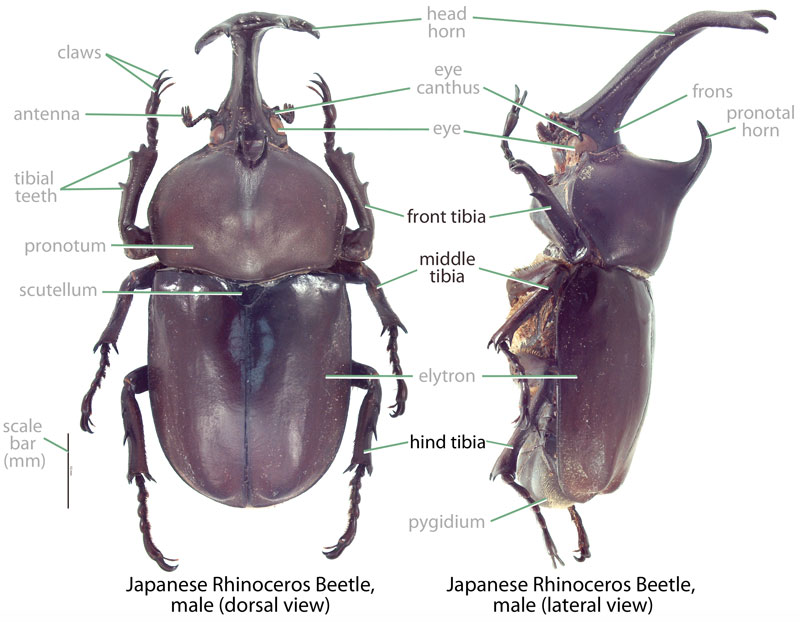 with 3 teeth at lateral margin; teeth may be worn in older specimens. Last sternitesternite:
with 3 teeth at lateral margin; teeth may be worn in older specimens. Last sternitesternite:
the ventral part of a thoracic or abdominal segment
 of female with apexapex:
of female with apexapex:
point or edge furthest from the body
rounded posteriorly; weakly quadratequadrate:
square-like in shape
in male.
Undescribed. For Adoretini (Ritcher, 1966Ritcher, 1966:
Ritcher P. 1966. White grubs and their allies: a study of North American scarabaeoid larvae. Oregon State University Monographs, Studies in Entomology 4: 1-219.): Grub C-shaped, not hump-backed, cylindrical, whitish. Maxillamaxilla:
set of paired mouthparts located posterior to the mandibles
with galeagalea:
outer branch or lobe of the maxilla
 and lacinialacinia:
and lacinialacinia:
inner portion of the maxilla entirely fused. Lacinialacinia:
entirely fused. Lacinialacinia:
inner portion of the maxilla of maxillamaxilla:
of maxillamaxilla:
set of paired mouthparts located posterior to the mandibles
with 3 unciuncus:
in scarab larvae, a hooked process on the distal margin of the maxilla
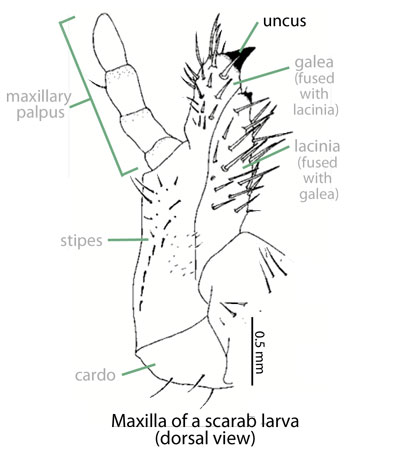 . Mandiblemandible:
. Mandiblemandible:
The crushing or chewing portion of an insects mouthparts
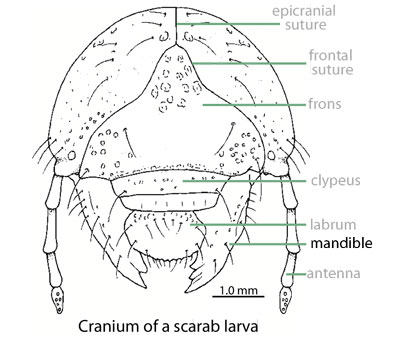 with a ventralventral:
with a ventralventral:
of or relating to the lower surface; opposite of dorsal
, oval, stridulatory area consisting of transversetransverse:
extending horizontally across a surface
, granular ridges. Maxillary stridulatory area with 8 or more, sharp, recurvedrecurved:
bending backwards
teeth. PlegmatiaPlegmatium:
in scarab larvae, a paired, lateral region with a somewhat sclerotized surface bordered by marginal spines with acanthoparia
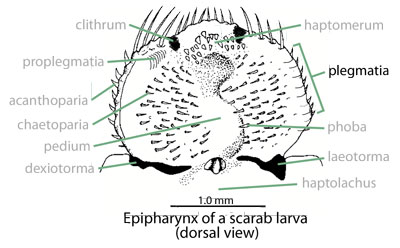 present. Haptomerumhaptomerum:
present. Haptomerumhaptomerum:
in larvae, the medio-anterior (middle of upper) portion of the epipharynx, composed of sensory spots
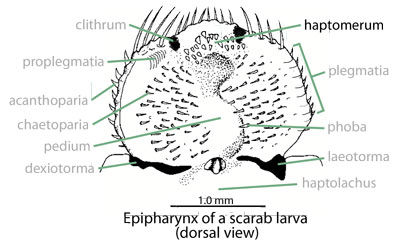 of epipharynxepipharynx:
of epipharynxepipharynx:
lobe on the interior surface of the labrum or clypeus
with a dense, transversetransverse:
extending horizontally across a surface
, comb-like row of 6–9 helihelus:
in scarab larvae, a coarse spine on or near the haptomerum
. Last antennal segment with a single, dorsaldorsal:
of or relating to the upper surface; opposite of ventral
sensory spot. Rasterraster:
in scarab larvae, a complex of setose, spiny, and bare areas on the ventral surface of the last abdominal segment with a subtriangular tegesteges:
with a subtriangular tegesteges:
in larvae, groupings of setae
of hamatehamate:
hook-like in shape
setae; palidiapalidium:
paired group(s) of recumbent (reclining) spines, usually occurring in rows; part of the raster
absent.
Asia, Africa. This beetle is widespread in the Old World tropics, with records from South Africa, India, Sri Lanka, Malaysia, Mauritius, Thailand, Indonesia, and Papua New Guinea (McQuate and Jameson, 2011McQuate and Jameson, 2011:
McQuate G and Jameson M. 2011. Sex determination in the Chinese rose beetle, Adoretus sinicus , and overview of Adoretus species of biosecurity concern. Journal of Insect Science 64: 1-18. full text (accessed 2015)).
This species has been recorded feeding on a range of economically important plants including lychee (Litchi chinensis) (McQuate and Jameson, 2011McQuate and Jameson, 2011:
McQuate G and Jameson M. 2011. Sex determination in the Chinese rose beetle, Adoretus sinicus , and overview of Adoretus species of biosecurity concern. Journal of Insect Science 64: 1-18. full text (accessed 2015)), rambutan (Nephelium lappaceum) (Muniappan, 2012Muniappan, 2012:
Muniappan R. 2012. Arthropod Pests of Horticultural Crops in Tropical Asia. CABI Publishing, Boston, USA.), rice (Oryza spp.) (International Rice Research Institute, 1986International Rice Research Institute, 1986:
Anonymous. 1986. Progress in upland rice research: Proceedings of the 1985 Jakarta conference. International Rice Research Institute, Manila, Philippines.), corn (Zea mays) (CIMMYT, 1989CIMMYT, 1989:
Anonymous. 1989. Toward insect resistant maize for the Third World: Proceedings of the 1987 International Symposium on Methodologies for Developing Host Plant Resistance to Maize Insects. CIMMYT, Mexico City, Mexico.), oil palm (Elaeis guineensis), banana (Musa spp.), rose (Rosa spp.), grape (Vitis spp.), okra (Abelmoschus esculentus), cotton (Gossypium spp.), sweet potato (Ipomoea batatas), coffee (Coffea spp.), cocoa (Theobroma cacao), and tea (Camellia sinensis) (Muniappan, 2012Muniappan, 2012:
Muniappan R. 2012. Arthropod Pests of Horticultural Crops in Tropical Asia. CABI Publishing, Boston, USA.).
Poorly known: This species is a generalist folivorefolivore:
an organism that feeds primarily upon plant foliage (leaves)
with the nocturnal adults feeding on a broad range of host plants (Pena et al., 2002Pena et al., 2002:
Pena J, Sharp J, Wysoki M. 2002. Tropical Fruit Pests and Pollinators: Biology, Economic Importance, Natural Enemies, and Control. CABI Publishing, Boston, USA.). Similar to Adoretus sinicus, host plants often show characteristic lace-like leaf damage to the leaves (Muniappan, 2012Muniappan, 2012:
Muniappan R. 2012. Arthropod Pests of Horticultural Crops in Tropical Asia. CABI Publishing, Boston, USA.). Eggs are laid in soil, often around plant roots. A report of five larval instars is likely erroneous (Pena et al., 2002Pena et al., 2002:
Pena J, Sharp J, Wysoki M. 2002. Tropical Fruit Pests and Pollinators: Biology, Economic Importance, Natural Enemies, and Control. CABI Publishing, Boston, USA.).
Significant. This species is a clear biosecurity hazard. It is known to feed on a wide range of economically important plant species and is closely related to species with clear histories of invasiveinvasive:
a species that has recently arrived to a new location, usually via human activity, causing notable economic and/or ecological damage
establishment (McQuate and Jameson, 2011McQuate and Jameson, 2011:
McQuate G and Jameson M. 2011. Sex determination in the Chinese rose beetle, Adoretus sinicus , and overview of Adoretus species of biosecurity concern. Journal of Insect Science 64: 1-18. full text (accessed 2015)). Damage from adult feeding can be significant enough to substantially lower fruit crop yields (Pena et al., 2002Pena et al., 2002:
Pena J, Sharp J, Wysoki M. 2002. Tropical Fruit Pests and Pollinators: Biology, Economic Importance, Natural Enemies, and Control. CABI Publishing, Boston, USA.).
Established. Nishida (2002) recorded this species from Oahu. Because of the great difficulty in separating this species from the common and extremely similar Adoretus sinicus, its abundance on the island is unclear.
Not established or recorded. There are no records of this species from Guam.
This species is attracted to lights at night, and it is likely that it would be attracted to well-lit ports and airports. This would allow for hitchhiking on marine or air cargo. Further, it is possible that adults or larvaelarvae:
the immature form of an insect; in scarabs, also called grub or white grub; preceded by the egg stage, followed by the pupal stage
 could be transported in the movement of nursery plants.
could be transported in the movement of nursery plants.
This species is extremely similar to the closely related Adoretus sinicus. The two species cannot reliably be separated based on external morphology. Identification requires dissection and examination of the male genitalia.
Adoretus umbrosus Burmeister
Report your observation of this species at our iNaturalist project.